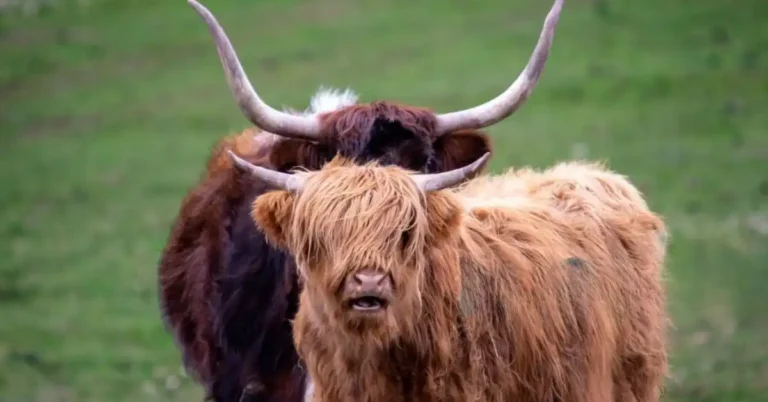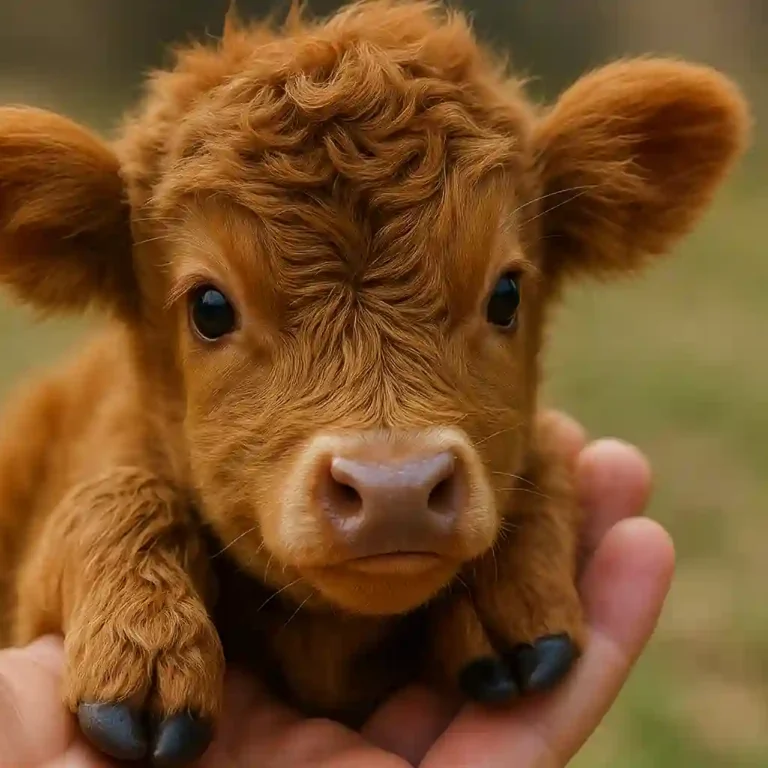How to Train and Handle Mini Highland Cow: Complete Guide
Mini Highland cows have captured the hearts of small-scale farmers and homesteaders worldwide with their adorable appearance, gentle temperament, and manageable size. While training and handling these magnificent creatures requires patience and dedication, the process is incredibly rewarding.
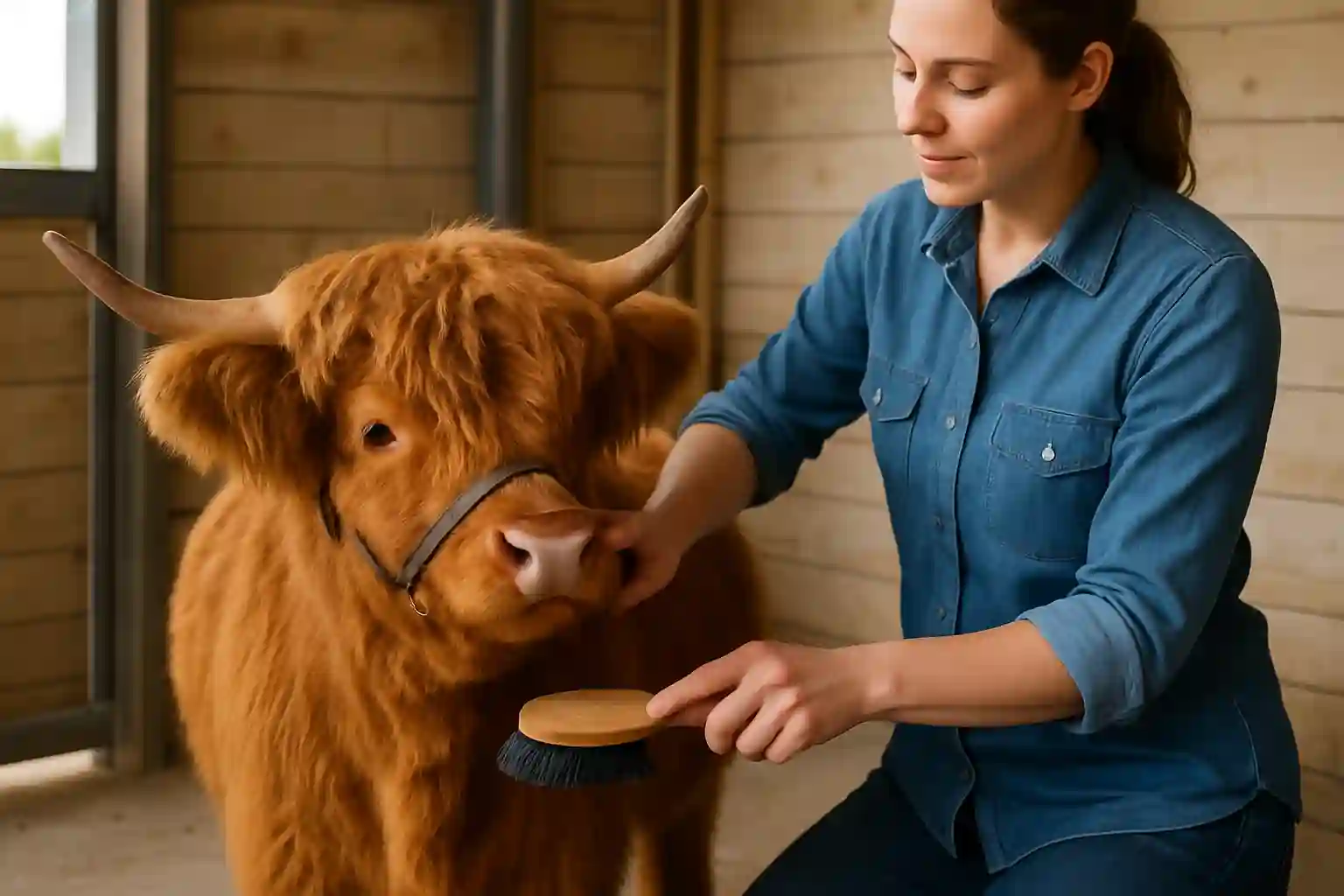
This comprehensive guide explores proven techniques to train and handle mini highland cow, for establishing trust, implementing positive reinforcement, and developing essential handling skills to create a harmonious relationship with your mini Highland cow.
Understanding Mini Highland Cow Behavior and Temperament
Mini Highland cows, standing 36-48 inches tall at the shoulder, are renowned for their docile nature and intelligence. These miniature versions of traditional Highland cattle retain all the charm of their larger counterparts while requiring less space and resources. With proper care, these remarkable animals can live 15-20 years, making them long-term companions for dedicated owners.
Natural Instincts and Social Structure
Mini Highland cows are naturally social animals that thrive in herds. In the wild, Highland cattle establish clear hierarchies, with dominant cows leading the group and protecting younger members. Understanding this social structure is crucial when introducing new animals to your herd or establishing yourself as the trusted leader.
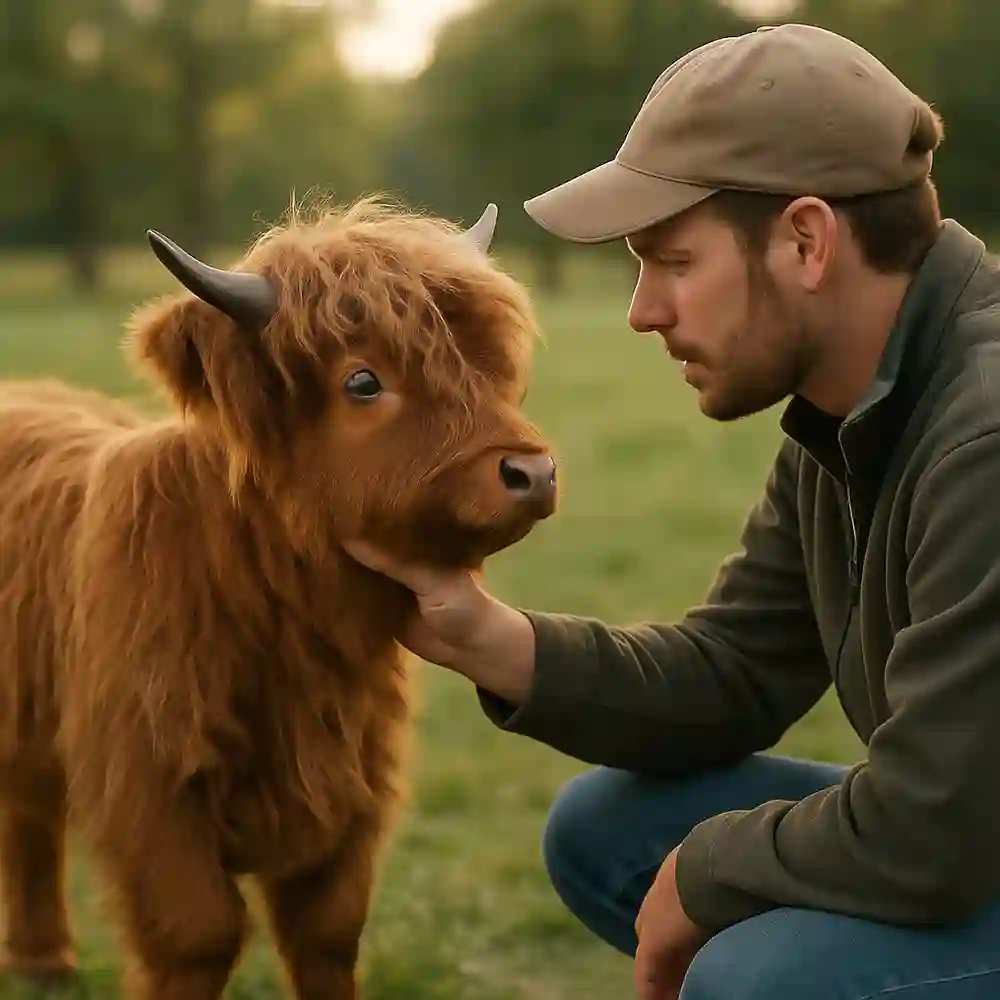
These animals communicate primarily through body language, using ear positions, head movements, and vocalizations to express their needs and emotions. Learning to read these subtle cues will significantly enhance your ability to train and handle your mini Highland cow effectively.
Common Behavioral to train and handle Mini Highland Cows
Mini Highland cows are known for several distinctive behavioral characteristics:
•Curiosity: They naturally investigate new objects, people, and situations, which can be leveraged during training.
•Intelligence: They quickly learn routines and can associate specific actions with rewards or consequences.
•Cautiousness: While generally friendly, they may initially be wary of unfamiliar situations or handling.
•Strong memory: They remember both positive and negative experiences, making consistent, positive interactions essential.
•Herd mentality: They feel safest in groups and may become stressed when isolated.
These behavioral traits form the foundation for effective training strategies. By working with these natural tendencies rather than against them, you’ll develop a stronger bond with your mini Highland cow and achieve better training results.
Essential Trust-Building Techniques
The cornerstone of successful mini Highland cow training is establishing a foundation of trust. Without this essential element, even the most sophisticated training techniques will fall short. Trust-building is not a one-time event but an ongoing process that begins the moment you bring your mini Highland cow home.
Creating Positive First Impressions
First impressions matter significantly when working with mini Highland cows. During initial interactions:
•Approach slowly and from an angle where the cow can clearly see you •Speak in a calm, consistent tone to help the animal associate your voice with safety •Avoid sudden movements or loud noises that might startle the cow •Allow the animal to initiate contact by sniffing your hand before attempting to touch it •Offer small treats from an open palm to create positive associations WRITE IT IN TABLE FORM
Remember that patience is crucial during this phase. Some mini Highland cows may warm up to you within days, while others might take weeks to fully trust you. Respect their individual pace and never force interactions.
Daily Interaction Strategies
Consistent daily interaction is vital for deepening the trust between you and your mini Highland cow. Implement these strategies:
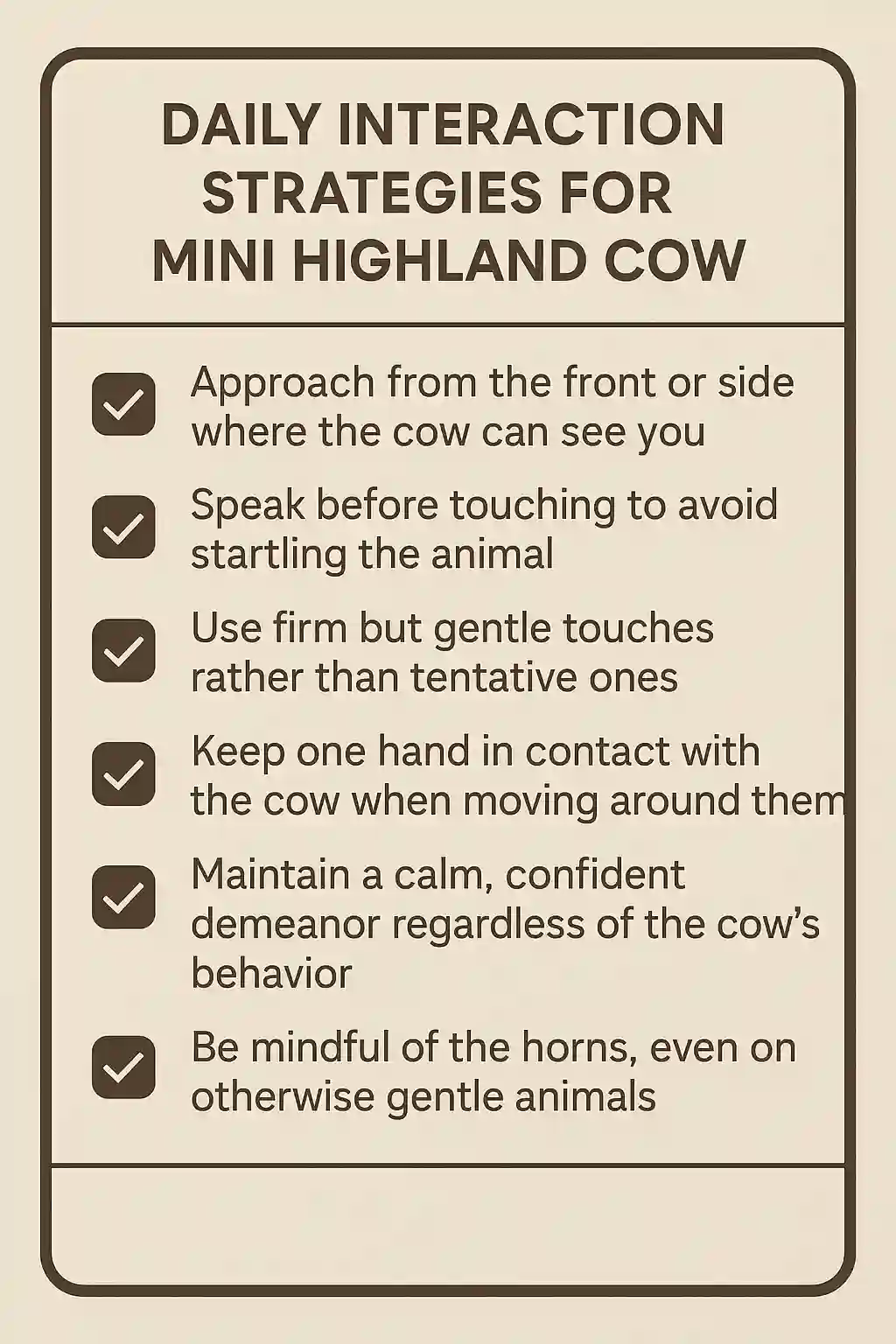
•Associate your arrival with positive experiences like treats or gentle scratching
Dedicating just 15-20 minutes daily to these interactions will significantly accelerate the trust-building process. The key is consistency even brief daily sessions are more effective than longer, sporadic interactions.
Reading Body Language and Responding Appropriately
Mini Highland cows communicate primarily through body language. Learning to interpret these signals allows you to respond appropriately: •Relaxed posture: Indicates comfort and receptiveness to interaction •Raised head with alert ears: Shows curiosity or mild concern •Lowered head with ears back: May signal fear or aggression •Tail swishing: Often indicates irritation or discomfort •Rumination (chewing cud): Suggests contentment and relaxation
When you notice signs of stress or discomfort, give the animal space and time to calm down before continuing. Respecting these boundaries demonstrates that you’re trustworthy, further strengthening your relationship.
Positive Reinforcement Training Methods
Positive reinforcement is the most effective and humane approach to training mini Highland cows. This method involves rewarding desired behaviors to increase their frequency while avoiding punishment that can damage trust and create fear.
Effective Rewards and Incentives
Choosing the right rewards is crucial for successful positive reinforcement training:
| Method | Description |
|---|---|
| 🍎 Food Treats | Small rewards like apple slices, carrots, or livestock treats to build trust |
| 🤲 Physical Affection | Gentle scratching behind the ears or along the neck—often a favorite for cows |
| 🗣️ Verbal Praise | Use of kind, consistent words in a happy tone to reinforce good behavior |
| ✋ Release of Pressure | Remove light pressure or stop cueing as soon as the cow responds correctly |
The timing of rewards is just as important as the rewards themselves. The reinforcement must occur immediately after the desired behavior—within 1-3 seconds—for the animal to make the connection between action and reward.
Mini Highland Cow Training Guide
| Category | Best Practices | Common Mistakes to Avoid |
|---|---|---|
| 🕒 Training Duration | Start with short sessions (5–10 min); increase gradually | Sessions too long – leads to fatigue |
| 📅 Routine & Timing | Train at the same time daily to build habit | Inconsistent timing – confuses the cow |
| 🎯 Skill Focus | Teach one behavior at a time until mastered | Expecting too much at once – causes stress |
| 🗣️ Cues & Commands | Use clear, consistent cues for each action | Changing commands – leads to confusion |
| ✅ Session End | Always end on a success to build confidence | Ending with failure or frustration – discourages learning |
| 👥 Handler Consistency | All handlers should use the same cues and reward system | Mixed handling approaches – breaks continuity |
| 😠 Emotional Control | Train only when calm and patient | Training while frustrated – negatively affects cow’s trust |
| 🙅 Discipline Approach | Focus on redirection and rewards | Using punishment – damages trust and creates fear |
Step-by-Step Halter and Lead Training
Halter and lead training are fundamental skills that make handling, veterinary care, and transportation safer and less stressful for both you and your mini Highland cow.
| 🔶 Section | 💡 Training Tip | 🚫 What to Avoid |
|---|---|---|
| 🟢 1. Halter Introduction | Let the cow see and smell the halter before putting it on | Forcing the halter onto a nervous cow |
| 🍎 Use treats to create a positive association | Skipping the reward phase | |
| ✋ Rub halter gently on the body to desensitize | Rushing the process | |
| 👃 Bring halter near face without securing it | Sudden or jerky movements | |
| 🔒 Secure halter calmly, then immediately offer a reward | Tightening harshly or too slowly | |
| ⏱️ Keep first sessions short (1–2 minutes), increase time gradually | Long, stressful first attempts |
| 🔷 2. Lead Training Techniques | 💡 Progressive Steps | 🚫 What to Avoid |
|---|---|---|
| 🏠 Start in a quiet, enclosed space with no distractions | Training in unfamiliar or busy locations | |
| 🪢 Attach lead rope and stand calmly beside the cow | Pulling or yanking the rope | |
| 👉 Apply gentle pressure + treat in direction of movement | Using force instead of encouragement | |
| 🏁 Release pressure the moment cow takes a step | Holding pressure after the desired response | |
| 📏 Gradually increase walking distance before rewarding | Expecting too much, too quickly | |
| 🗣️ Use simple verbal cues like “walk” and “stop” | Changing commands or tone frequently | |
| 🌍 Introduce new areas gradually | Overwhelming the cow with big environmental changes too soon |
| 🔴 3. Troubleshooting Common Issues | ⚠️ Problem | ✅ Solution |
|---|---|---|
| 🐄 Halter resistance | Go back to basics: shorter sessions + treats | Build positive association slowly |
| ⛔ Pulling back | Apply gentle side pressure, not direct | Wait for a forward step, then reward |
| 🧍♀️ Refusing to move | Use a target stick or visible treat | Never increase rope tension to force movement |
| 🏃♂️ Rushing ahead | Stop moving completely until calm returns | Resume slowly with more control |
| 🌆 Distracted in new settings | Brief, calm exposure to new environments | Return to known space if overwhelmed |
Pro Tip: Regression is normal. If your cow struggles, return to the last successful step. Rebuild confidence before progressing again.
Always prioritize patience, calm tone, and gentle handling to create lasting, positive behavior.
Teaching Basic Commands and Boundaries
Teaching your mini Highland cow to respond to basic commands enhances safety and makes daily handling more efficient. A well-trained mini Highland cow can be directed with minimal physical guidance, reducing stress for both animal and handler.
Essential Commands Every Mini Highland Should Know
Training your mini Highland to respond to a few simple commands can make daily handling a whole lot easier (and safer!). Here are the basic ones to focus on:
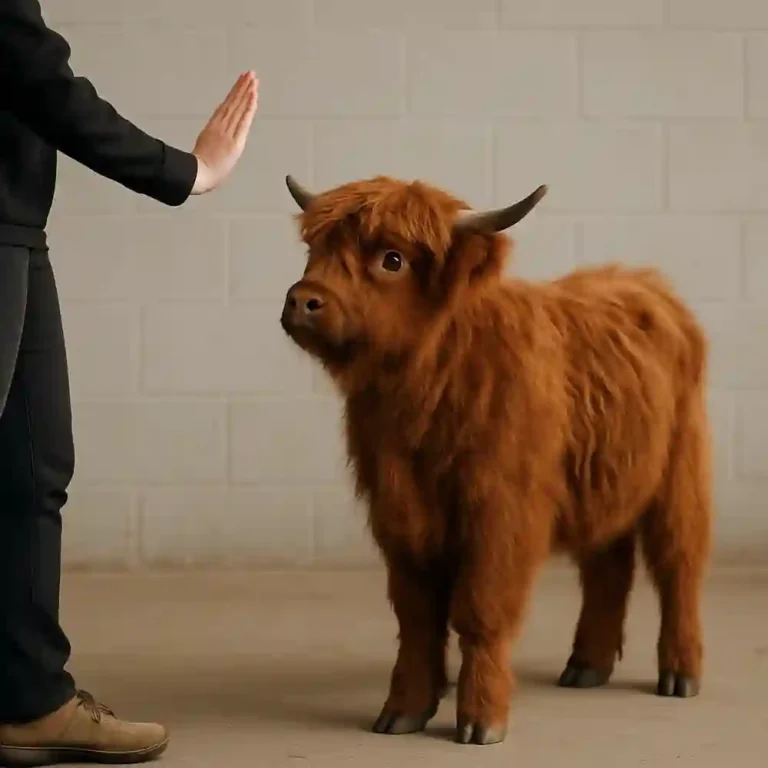
- “Stop” or “Whoa” – Tells your cow to halt right away. Super helpful if they start to wander or move too fast.
- “Walk” or “Come” – Encourages them to move forward or come to you—great for lead training.
- “Back” – Gets your cow to take a step or two backward—useful in tight spaces.
- “Stand” – Tells them to stay still during grooming or vet checks.
- “Over” – Guides your cow to shift sideways, like when you need space or want to adjust their position.
Start out in a quiet space, like their pen or a familiar paddock. Use a halter and lead rope to guide them as you say the command. Pair your words with consistent hand or lead cues. Eventually, they’ll catch on and respond just to your voice!
Command Training Progression
Like anything new, teaching commands takes time and patience. Here’s a good way to go about it:
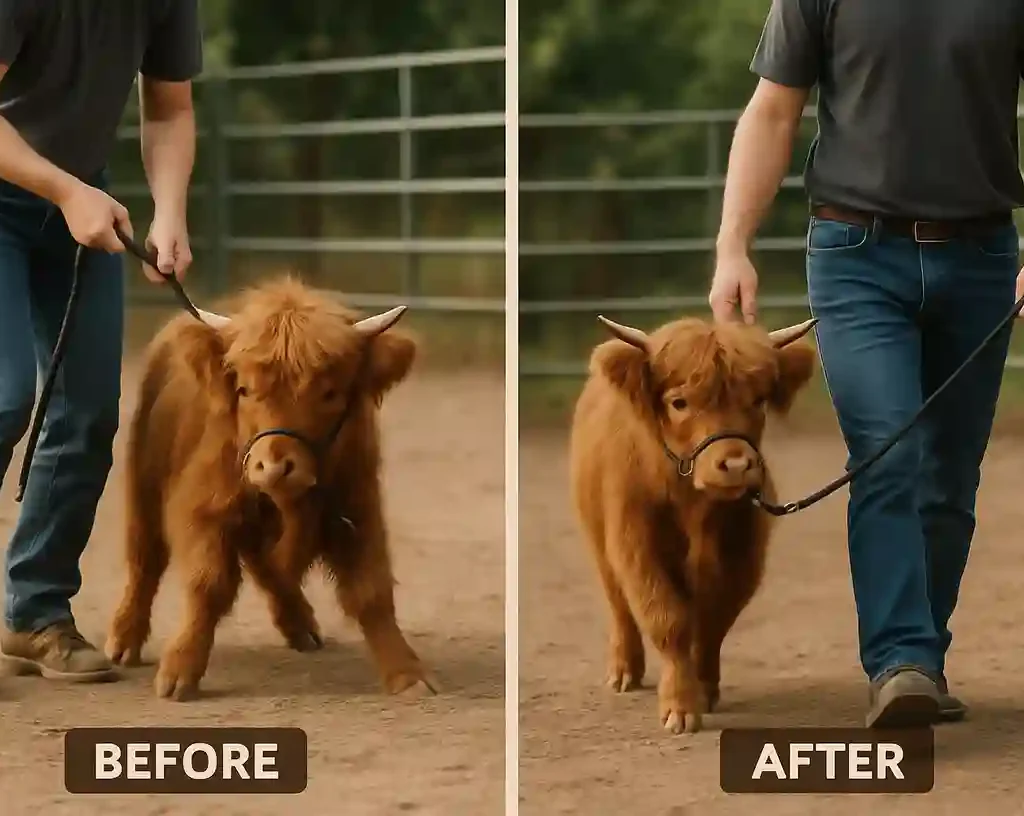
- Say the command while gently guiding them to do the action.
- Reward them right away when they get it right—a treat, a rub, or praise works great.
- Slowly use less physical guidance, relying more on your voice.
- Start making them hold the behavior longer—like “stand” for 5 seconds, then 10, and so on.
- Practice in different places with new distractions to build reliability.
- Try chaining commands together, like “stop” and then “back.”
Use the same word and tone every single time. Short, simple commands are easier for your cow to understand and remember.
Reinforcing Boundaries and Safe Handling
Even if they’re cute and fluffy, mini Highland cows are still strong animals—and they grow fast. Teaching good manners early on helps avoid headaches later.
Here’s what to work on:
- Show them it’s not okay to push into your space. Step away or gently correct it.
- No headbutting or rubbing—even if it seems playful, don’t let it become a habit.
- Always reward calm, respectful behavior like standing still.
- Be consistent with rules. If it’s not allowed, it’s never allowed.
- Make sure everyone in the family follows the same rules and cues.
Cows thrive on consistency and clear signals. The sooner they know what’s okay (and what’s not), the better the bond and the easier your life will be.
Essential Care for Training Success
Proper care directly impacts your mini Highland cow’s trainability and behavior. Animals that are healthy, well-nourished, and comfortably housed are more receptive to training and easier to handle.
| Situation | Key Handling Techniques |
|---|---|
| Everyday Interaction | Approach from front or side where visible. Speak before touch. Use firm, gentle contact. Keep one hand on the cow while moving. Stay calm and confident. Watch out for horns. Consistent behavior builds trust. |
| Health Checks & Grooming | Use halter and lead rope for control. Consider grooming stand. Start with less sensitive areas (neck/shoulders) before feet/face. Work front to back. Gradually introduce tools like brushes and hoof picks. Reward calm behavior. |
| Transportation | Practice loading/unloading beforehand. Use cattle-appropriate trailer with non-slip flooring. Ensure ventilation without drafts. Drive smoothly. Bring a calm companion animal for nervous cows. |
Care for Training Success
| Aspect | Key Guidelines |
|---|---|
| Nutrition for Good Behavior | – Provide high-quality forage (grass/hay) as diet base – Use cattle-specific mineral supplements – Limit grain to avoid obesity – Fresh, clean water at all times – Adjust feed per age, size, activity – Make dietary changes gradually over 7–10 days |
| Healthcare & Prevention | – Follow a vet-advised vaccination schedule – Use parasite control suited to your region – Trim hooves every 6–8 weeks – Watch for signs of illness or pain – Ensure regular dental check-ups |
| Shelter & Space Needs | – Minimum 200 sq. ft. indoor space per cow – 1–2 acres of pasture access per cow – Shelter should block harsh weather but ventilate well – Separate feeding and resting areas – Allow social interaction; they are herd animals |
Building a Lifelong Bond with Your Mini Highland Cow
Training is not a finite process but an ongoing relationship that continues throughout your mini Highland cow’s life. The bond you develop will deepen over time with consistent positive interactions. To keep your mini Highland cow mentally engaged, continue training and enrichment regularly. Introduce new, ability-appropriate challenges and reinforce familiar skills to prevent boredom.
Activities like obstacle courses, target training, or even light cart-pulling (for suitable cows) provide great mental stimulation and strengthen your bond. Equally important is creating positive shared experiences. Discover your cow’s favorite scratching spots, go for walks in safe enclosures, and establish routines you both enjoy.
Gradually introduce new experiences with plenty of support and reward good behavior generously. As you progress, celebrate training milestones set realistic goals, track them with photos or videos, and share achievements with fellow owners. Every mini Highland cow learns at its own pace, so focus on your individual journey and enjoy each step together.
Conclusion
Training and handling mini Highland cows combines science, art, and patience. By understanding their natural behaviors, establishing trust, using positive reinforcement, and providing appropriate care, you’ll develop a rewarding relationship with these remarkable animals.
The time invested in proper training yields dividends in safety, ease of handling, and the special bond that develops between human and animal. Whether you’re raising mini Highland cows for companionship, sustainable farming, or conservation of this special breed, the principles outlined in this guide will help you create a harmonious and productive partnership.
With consistency, kindness, and clear communication, your mini Highland cow can become a well-mannered, easily handled member of your farm family for many years to come.
